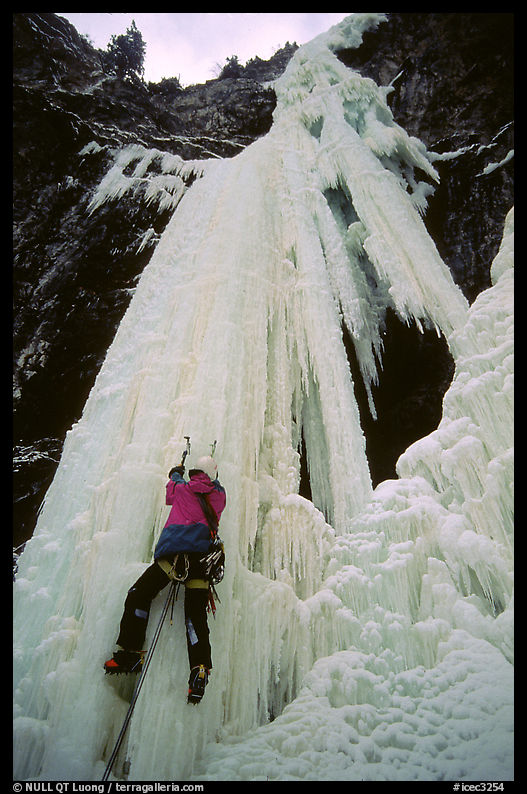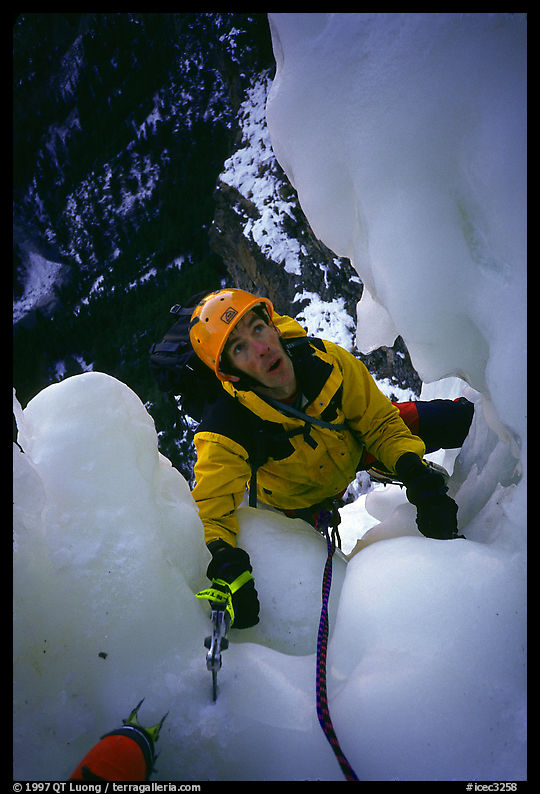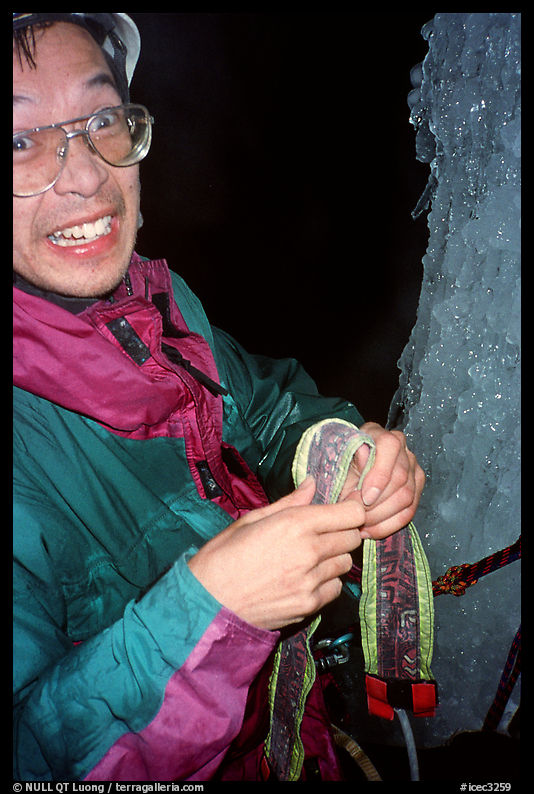The Theft, 1996
5 Comments
The Alpinist, available online for a month (Update: free stream available) is the best climbing film I have seen. Watching brought back memories of my previous life in the mountains, and a particular apex moment, the subject of this post. In 1993, I adopted the large format camera and by the end of 1995, my longest vacation had been a road trip centered around photographing the national parks. However, at that time, I was still obsessed with climbing. Although it was the lure of Yosemite and its big walls that had brought me to California, my love and best abilities resided in the cold mountains.

From the start, I was more attracted by adventure than by gymnastic exercise – at which I am not good at all. On a large scale, the mountains offered a backdrop more awesome than the cliffs and boulders where the difficulty of rock climbing is pushed to its limits. On a smaller scale, the beauty of translucent curtains of waterfall ice festooned with innumerable icicles felt more otherwordly than any rock wall. It isn’t uncommon to find yourself on a thin freestanding column, surrounded by air in almost all directions. The mountains had been so compelling to me because they represented another world.
One could argue that the experience of the rock climber is more directly connected to nature since he holds directly on the rock, whereas the ice climber relies on tools such as crampons and ice axes. However, our knowledge of the world often comes to us through tools that are extensions of the body and mind. The art of photography also entirely relies on tools for personal expression. I felt that using tools was simply a way to amplify my experience. There was a particular satisfaction in finding the confidence to hang out from the pick of an ice-ax penetrating only a fraction of an inch into frozen water. Besides the biting cold, wind, and the fall of ice chunks, that experience felt connected to the mountains as I needed to develop the knowledge or instinct of the changing conditions that critically affect a climb. Rock walls are unchanged. A quick warm spell can cause a frozen waterfall to collapse. A quick freeze may render the ice prone to shattering. A frozen slope may be firm and safe to climb at night and in the early morning and become dangerous in the afternoon.

The peaks where I debuted in mountaineering were all snowy high mountains. Through pressure and the cycle of melting and refreezing, snow transforms into alpine ice. The slopes in the mountains are generally quite far from vertical, so the climbs are more about endurance and route-finding than technical difficulty. Thanks to modern ice tools, I soon felt confident enough to venture into the 1,400-meter high (4,600 ft) East Face of Mont-Blanc (the last three photos here) where I climbed solo a trio of routes of increasing difficulty, the Brenva Spur, Red Sentinel, and Grand Pilier d’Angle, experiencing an exhilarating sense of freedom and wildness.
In the 1970s, climbers began exploring a more transient territory, low-altitude water ice, which can generally be described as frozen waterfalls. Presenting vertical sections, they are steeper than the gullies and couloirs found in the mountains and feature a more complex and brittle quality of ice, adding up to a considerable technical challenge. Their ephemeral beauty, allure, fragility, and the improbability of the climbs mesmerized me. In the 1980s, I learned ice-climbing from Godefroy Perroux, one of the pioneers of that discipline.

In all fields of human endeavor, committed practitioners aim to leave a mark by making something new. In science, you write papers describing discoveries. In art, you create novel and original artworks. In climbing, you seek to establish new routes. During the winter of 1996, I participated in the fourth ascent of Sea of Vapors, leading the majority of pitches (photo above). Conditions were easier, but the line still had the aura of being considered the hardest in the world when first climbed in 1993, defining what was possible at that time.
Afterward, I felt ready to try a first ascent of my own. The occasion presented itself in February of that year when climber Eric Hirst alerted me of an opportunity in British Columbia. It took two flights from California and a very long day with even Canadian police on the scene. Due to the proximity with The Gift and the peculiar circumstances of the ascent, my partner Kevin Normoyle and I named it The Theft. I won’t repeat details here, they are in Eric’s report and mine, both written shortly after the ascent, and also summarized in the notes below.



On the first picture above taken during the first attempt by either Adrian Burke or Lee Purvis, I start leading the headwall. The second is of Kevin Normoyle looking with some perplexity at the fifth pitch during the second attempt. After having finished that crux pitch in the dark, you can see my excitement of being only one pitch away from completing the climb in the picture of me Kevin took.



The first image above reproduces the notes that I penciled on the last page of my copy of the guidebook West Coast Ice (first edition) by Don Serl and Bruce Kay. The page of the second edition of the same guidebook describing “The Theft” is shown on the second image. In the third, a still from The Alpinist (55:11) Marc-André Leclerc holds the guidebook. The authors noted that “Subsequent ascents will be exceedingly rare”.
Indeed. It took twenty-two years for the line to receive its second ascent. Marc-André Leclerc was the best alpinist of his generation. As now plainly evident to all in The Alpinist, his unassuming demeanor and free-spirited, ascetic lifestyle belied a supernatural mastery in the mountains. Although at a considerably more modest level, I’ve done a bit of alpinism using the same rules of engagement as Marc-André’s: no rope, no communication device, nor prior reconnaissance. In the movie, Barry Blanchard said that this game is only “for the best alpinists on their best days”, but that is true only of cutting-edge routes. The movie shook and moved me because I could relate to Marc-André’s pure-hearted obsession on a personal level. The Theft is listed on his Wikipedia page as one of his notable climbs and his latest before the fatal outing on the Mendenhall Towers less than a month later. I was honored that we had shared the same route – we are to date the two only people to have led the upper column, and that after the second ascent, Marc-André affirmed:
“It must be the best waterfall climb in southwestern B.C. without question.”Below are distant views of the climb in 1996 on the day before the first ascent and during Marc-Andre Leclerc’s climb in 2018 in more difficult conditions:

Of all the climbing sub-specialties, ice climbing suited me the best because the activity was so much about determination, skill, mental strength (some would translate that as “balls”, or according to my acrophobic wife, a deficient sense of danger), willingness to suffer, and less about physical prowess. Yet, I knew that I had already pushed my natural abilities, and therefore my luck. In high school, I was a frail kid who skipped all the physical education classes. It was mostly by sheer willpower that I got into the world of alpinism, but I wasn’t deluding myself into thinking that I was as strong as most of my partners. In the subsequent years, my two closest climbing friends would perish in the mountains, and so would my ice-climbing mentor.
I didn’t plan it that way, but for a variety of reasons, The Theft turned out to be my last water ice climb. Maybe it was wise to move on after such a high point. Surpassing it would have meant taking greater risks in the inherently dangerous environment of the steeper mountains. I let it go. Besides fond memories, I was content that as a person of ordinary ability, I had managed to do something out of the ordinary. The void left by this departure didn’t last long, as it immediately filled up with photography.


Hi Tuan,
I hope you’re well. Great to see you’ve been busy and productive.
Thanks for this retrospective. Wow … Marc-André Leclerc ended up being your second ascensionist, eh? And in his final year? Well, your extraordinary climb has aged well.
We hope to be back in the Tetons this August. I look forward to the next time we get to hang out.
Hello Chris, good to hear from you. Marc-André Leclerc passed away less than a month after climbing the Theft. I have fond memories from the Tetons trip, thanks again for inviting us to your campsite. We were so impressed that you did two single-day ascents of the Grand in the span of a few days. Wish you a great summer trip!
hi qt luong, i love u sm very cool content
Hi Tuan,
I had the pleasure of climbing the theft a couple of days ago with Tony Richardson. An absolutely stunning line which turned out to be quite extraordinary. The last pitch that we climbed by headlamp was full value !
Climbing a route like this back in the day with tools and shit ice screws that existed in 1996 is an amazing effort. What a dream line, and one of the best I’ve climbed anywhere in the world
Thank you, Tim, for doing me the honor of stopping by and commenting. In the day, we may have tools less refined than what is available today, but we had also leashes. They helped me a lot. With my limited strength, I would not have been able to climb the route with the modern leash-less standards!
P.S. for readers: You can clearly see by comparing my photo with what Tim posted on Instagram that in 1996, the conditions were much easier since there was more ice. Yet Tim’s appreciation of the route means a lot to me, since he was the first to climb a WI 10 frozen waterfall (which means that he pushed the state-of-the-art one grade up from WI 9 which was then the highest difficulty rating), then the first to climb a WI 11, WI 12, and WI 13.